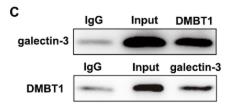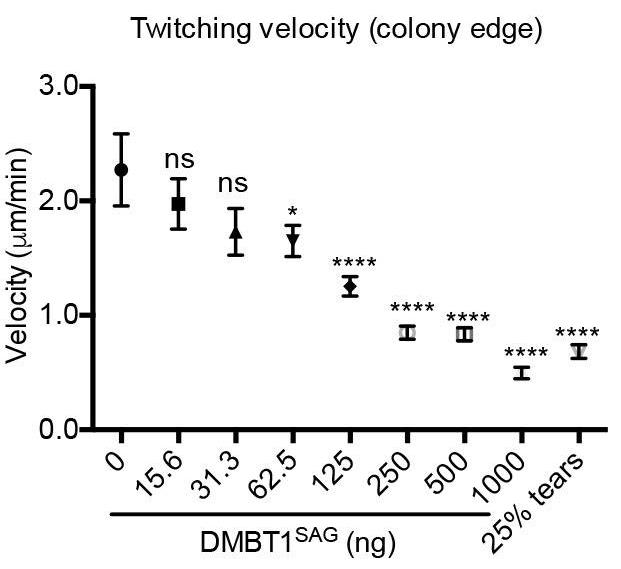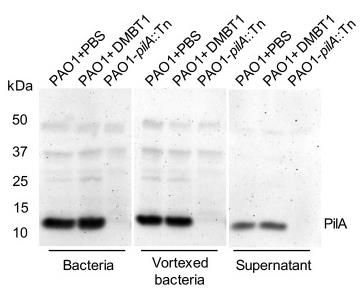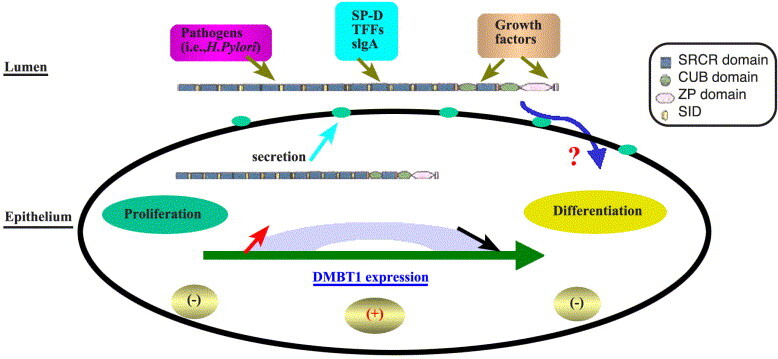Recombinant Human DMBT1 protein(Met1-Ser220), His-tagged
| Cat.No. : | DMBT1-3231H |
| Product Overview : | Recombinant Human DMBT1 (NP_004397.2) (Met 1-Ser 220) was expressed in HEK293, fused with a polyhistidine tag at the C-terminus. |
| Availability | April 16, 2025 |
| Unit | |
| Price | |
| Qty |
- Specification
- Gene Information
- Related Products
- Case Study
- Application
- Download
| Species : | Human |
| Source : | HEK293 |
| Tag : | His |
| Protein Length : | 1-220 a.a. |
| Form : | Lyophilized from sterile PBS, pH 7.4. Normally 5 % - 8 % trehalose, mannitol and 0.01% Tween80 are added as protectants before lyophilization. |
| Bio-activity : | 1. Measured by its binding ability in a functional ELISA. 2. Immobilized recombinant human Galectin-3 at 10 μg/ml (100 μl/well) can bind biotinylated DMBT1-His with a linear range of 0.06-1.0 μg/ml. |
| Molecular Mass : | The recombinant human DMBT1 consists of 211 amino acids and has a predicted molecular mass of 22.6 kDa. The apparent molecular mass of rh DMBT1 is approximately 35-45 kDa in SDS-PAGE under reducing conditions due to glycosylation. |
| Endotoxin : | < 1.0 EU per μg of the protein as determined by the LAL method |
| Purity : | > 95 % as determined by SDS-PAGE |
| Storage : | Samples are stable for up to twelve months from date of receipt at -20°C to -80°C. Store it under sterile conditions at -20°C to -80°C. It is recommended that the protein be aliquoted for optimal storage. Avoid repeated freeze-thaw cycles. |
| Reconstitution : | It is recommended that sterile water be added to the vial to prepare a stock solution of 0.2 ug/ul. Centrifuge the vial at 4°C before opening to recover the entire contents. |
| Gene Name | DMBT1 deleted in malignant brain tumors 1 [ Homo sapiens ] |
| Official Symbol | DMBT1 |
| Synonyms | DMBT1; deleted in malignant brain tumors 1; deleted in malignant brain tumors 1 protein; GP340; muclin; SAG; gp-340; hensin; glycoprotein 340; salivary agglutinin; surfactant pulmonary-associated D-binding protein; FLJ61058; MGC164738; |
| Gene ID | 1755 |
| mRNA Refseq | NM_004406 |
| Protein Refseq | NP_004397 |
| MIM | 601969 |
| UniProt ID | Q9UGM3 |
| ◆ Recombinant Proteins | ||
| DMBT1-1549R | Recombinant Rat DMBT1 Protein, His (Fc)-Avi-tagged | +Inquiry |
| DMBT1-4641M | Recombinant Mouse DMBT1 Protein | +Inquiry |
| DMBT1-1890R | Recombinant Rat DMBT1 Protein | +Inquiry |
| DMBT1-3231H | Recombinant Human DMBT1 protein(Met1-Ser220), His-tagged | +Inquiry |
| DMBT1-1351H | Recombinant Human DMBT1 Protein, His-tagged | +Inquiry |
| ◆ Cell & Tissue Lysates | ||
| DMBT1-2407HCL | Recombinant Human DMBT1 cell lysate | +Inquiry |
Case 1: Ma N, et al. Cell Biochem Funct. 2020
DMBT1 suppresses ovarian cancer progression by inhibiting galectin-3/PI3K/AKT signaling, reducing cell proliferation, migration, and MMP expression while enhancing cisplatin sensitivity. Overexpression of DMBT1 in SKOV3 cells reverses oncogenic phenotypes, positioning it as a tumor suppressor and potential biomarker for novel therapeutic strategies in ovarian cancer treatment.

Fig1. The protein expression level of DMBT1 in a human normal ovarian epithelial cell line (NOEC) and four human ovarian cancer cell lines was measured using western blot assay.

Fig2. The interaction between DMBT1 and galectin-3 was verified by IP assay.
Case 2: Li J, et al. PLoS Pathog. 2017
Human tear fluid inhibits Pseudomonas aeruginosa corneal infection via DMBT1-mediated suppression of bacterial twitching motility, independent of antimicrobial activity. DMBT1 binds pili to block surface traversal and reduce disease pathology in vitro and in vivo, revealing a non-canonical mucosal defense mechanism targeting virulence rather than bacterial viability.

Fig1. Purified DMBT1 from saliva inhibited P. aeruginosa PAO1 twitching velocity and colony size expansion in a dose-dependent manner.

Fig2. Western immunoblot of PilA expression in P. aeruginosa PAO1 after DMBT1 (100 ng/μl) treatment on twitching media for 4 h.

Fig1. DMBT1 links gut inflammation to epithelial differentiation by binding pathogens and factors. (Weiqun Kang 2003)
Not For Human Consumption!
Inquiry
- Reviews
- Q&As
Ask a Question for All DMBT1 Products
Required fields are marked with *
My Review for All DMBT1 Products
Required fields are marked with *
Inquiry Basket


